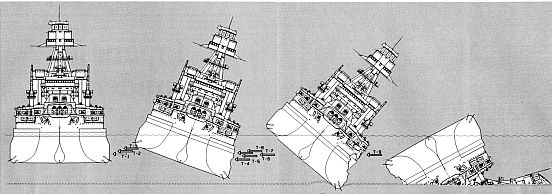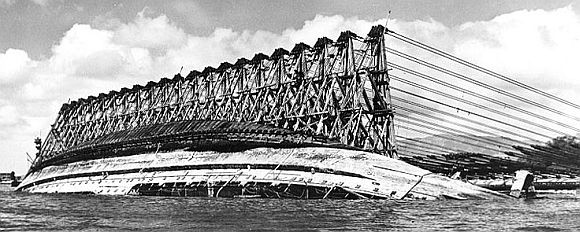 On the morning of December 7, 1941, USS Oklahoma was moored at an outside berth in the inner harbor at Pearl Harbor, Hawaii. When the Japanese attacked Pearl Harbor that day, the USS Oklahoma was directly in the flight path of the attacking planes. USS Oklahoma was struck by nine torpedoes and rolled over in roughly 10 minutes. The diagram above shows the sequence of the capsize and the torpedo strikes that doomed the ship and four hundred and twenty-nine of her crew.
On the morning of December 7, 1941, USS Oklahoma was moored at an outside berth in the inner harbor at Pearl Harbor, Hawaii. When the Japanese attacked Pearl Harbor that day, the USS Oklahoma was directly in the flight path of the attacking planes. USS Oklahoma was struck by nine torpedoes and rolled over in roughly 10 minutes. The diagram above shows the sequence of the capsize and the torpedo strikes that doomed the ship and four hundred and twenty-nine of her crew.
The USS Oklahoma was the last ship to be salvaged at Pearl Harbor. The ship weighted about 32,000 metric tons and was rolled almost 180 degrees. To right the ship, the Navy used a salvage technique called parbuckling. Large A frames were mounted along the length of the hull to provide the leverage necessary to roll the ship. The process took roughly four months and was finished in June 1943. The ship was judged too damaged to be repaired. On the tow to a scrap yard in California, the USS Oklahoma sank in a storm in May 1947.
Salvage of the Battleship USS Oklahoma Following the Attack on Pearl Harbor 1942 1942-46
 The parbuckling salvage of the USS Oklahoma was briefly in the news recently when the Costa Concordia was parbuckled where it sank on the island of Giglio, Italy.
The parbuckling salvage of the USS Oklahoma was briefly in the news recently when the Costa Concordia was parbuckled where it sank on the island of Giglio, Italy.

So the government spent all that money to right the ship, then lost it.
No wonder the government is broke!
Should have sunk in in deep water somewhere out of the Hawaiian shipping lanes.
Good lord man World War 2 was on !! Our Nation was busy trying to survive – which it did and is likely why you are here free to write comments. Where is AKISMET when you need it ???
Good Watch.
Capt,
Thanks for the comment about this Phil . He obviously has NEVER served and doesn’t know what it means to have Honor, Courage, or Commitment as well as our old Code; Duty, Honor, and Country. My uncle died on the Oklahoma and as of today, his remains have yet to be identified. Our nation did NOT start WWII but we helped to end it. Maybe Phil should realize that if it was NOT for our greatest generation, we would NOT be free
Fred, I think that you miss Phil’s point, which was simply to point out the irony of going to such and effort to raise a ship that then sank in transit. I suspect the first goal, at the time, was not salvaging the ship itself, in any case, but simply clearing the berth where it sank.